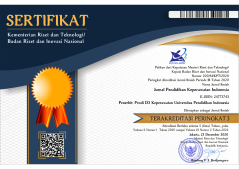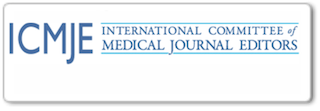A NOVEL OF BIOMEDICAL APPROACH FOR HIV PREVENTION: AN INTEGRATED LITERATURE REVIEW
Abstract
ABSTRAK
Secara global, jumlah kasus baru terinfeksi Human Immunodeficiency Virus (HIV) sudah mengalami penurunan yang signifikan. Akan tetapi dibeberapa wilayah negara seperti Afrika dan Asia Tenggara, jumlah kasus baru terinfeksi HIV masil mengalami peningkatan. Upaya pencegahan seperti promosi penggunaan kondom, sunat bagi laki-laki, dan skrining HIV sudah diimpementasikan dengan baik. Tetapi, pendekatan tersebut tetap saja tidak menghilangkan seseorang terkena resiko HIV bahkan mungkin untuk pasangan yang hidup dengan penderita HIV malah meningkatan resiko mereka tertular HIV. Sehingga dibutuhkan suatu pendekatan lain yang efekti dan mampu meminimalkan sekecil-kecilnya resiko seseorang tertular HIV. Tujuan dari review ini adalah untuk mengkaji efektifitas pendekatan baru yang dikenal dengan pendekatan biomedik terhadap penurunan resiko tertular HIV. Melalui pencarian secara komprehensif di beberap sumber data seperti PubMed, Embase, Cochrane Library, clinicaltrials.gov, htpn.org, and meta-register dilakukan terutama berfokus pada studi yang diterbitkan dalam Bahasa Inggris pada tahun 2005 sampai 2015. Hasil dari pengkajian tersebut menunjukan bahwa pendekatan biomedik seperti pre-exposure prophylaxis (PrEP) dan post exposure prophylaxis (PEP) merupakan suatu pendekatan yang terbukti efektif dalam menurunkan penularan HIV terutama pada kelompok-kelompok dengan resiko tinggi seperti homoseksual atau heteroseksual. Sehingga, pemerintah Indonesia mungkin sudah bisa melakukan pengkajian yang dalam dan membuat pedoman tatalaksana pencegahan HIV dengan pendekatan ini.
ABSTRACT
The number of new cases of Human Immunodeficiency Virus (HIV) infections has decreased significantly worldwide. However, in some regions such as Africa and South East Asian, new HIV infections remain high. Prevention strategies such as promoting condom use, male circumcision, and early HIV detection have been implemented well. However, all those approaches still putting people at high risk of HIV infection. The purpose of this review is to summarize current evidence about biomedical approach as an effective HIV prevention. A comprehensive computerized literature search was conducted using PubMed, Embase, Cochrane Library, clinicaltrials.gov, htpn.org, and meta-register to retrieved relevant literature published from 2005 to 2015 in English to review a current approach for HIV prevention. Biomedical approaches using antiretroviral drugs have shown good efficacy in the prevention of mother-child transmission for post exposure prophylaxis. Recent evidence has also found pre-exposure prophylaxis (PrEP) to be promising in preventing HIV. Both WHO and CDC recommended to integrate PrEP and post exposure prophylaxis for HIV prevention strategies. Health care policy needs to consider the biomedical approach to HIV prevention, especially in Indonesia. Therefore, Indonesia government may start to develop a clinical guideline and deeply assess the possibility to implement this approach in clinical practice.
Keywords: biomedical approach, prevention, HIV, treatment
Keywords
Full Text:
PDFReferences
Anderson PL, Glidden DV, Liu A, et al. (2012). Emtricitabine-tenofovir concentrations and preexposure prophylaxis efficacy in men who have sex with men. Sci Transl Med.4:151ra125.
Baeten JM, Donnell D, Ndase P, et al. (2012). Antiretroviral prophylaxis for HIV prevention in heterosexual men and women. N Engl J Med. 367(5):399-410.
Buchbinder, S. P., Glidden, D. V., Liu, A. Y., McMahan, V., Guanira, J. V., Mayer, K. H., . . . Grant, R. M. (2014). HIV pre-exposure prophylaxis in men who have sex with men and transgender women: a secondary analysis of a phase 3 randomised controlled efficacy trial.
The Lancet infectious diseases, 14(6), 468-475.
CDC. (2012). Interim guidance for clinicians considering the use of pre exposure prophylaxis for the prevention of HIV infection in heterosexually active adults. MMWR Morb Mortal Wkly Rep. 61(31):586-589.
CDC. (2011). Interim guidance: pre-exposure prophylaxis for the prevention of HIV infection in men who have sex with men. MMWR Morb Mortal Wkly Rep. 2011;60(3):65-68.
CDC. (2014). Preexposure Prophylaxis for the Prevention of HIV Infection in the United States – 2014 Clinical Practice Guideline. US Public Health Service.
CDC. (2016). Updated guidelines for antiretroviral post-exposure prophylaxis after sexual, injection drug use, or other non-occupational exposure to HIV—United States, 2016. US Public Health Service.
Cohen MS, Chen YQ, McCauley M, et al. (2011). Prevention of HIV-1 infection with early antiretroviral therapy. N Engl J Med. 365(6):493-505
Dara A. Lehman, Jared M. Baeten, Connor O. McCoy, Julie F. Weis, Dylan Peterson, Gerald Mbara, Deborah Donnell, Katherine K. Thomas,
Craig W. Hendrix, Mark A. Marzinke,8,9,10 Lisa Frenkel, Patrick N. ( 2015). Risk of Drug Resistance among Persons Acquiring HIV within a Randomized Clinical Trial of Single- or Dual-Agent Pre exposure Prophylaxis. Journal of Infectious Diseases Advance. DOI: 10.1093/infdis/jiu677
Del Rio. (2015). HIV Prevention: Integrating Biomedical and Behavioral. Biomedical and Behavioral HIV Prevention 22 (5).
Douglas S. Krakower & Sachin Jain & Kenneth H. Maye. (2015). Antiretroviral for Primary HIV Prevention: the Current Status of Pre- and Post-exposure Prophylaxis.Curr HIV/AIDS Rep. DOI 10.1007/s11904-014-0253-5
Gottfried Hirnschall1, Anthony D Harries, Philippa J Easterbrook , Meg C Dohertyand Andrew Ball. (2013) .The next generation of the World Health Organization’s global antiretroviral guidance. Journal of the International AIDS Society 16. http://dx.doi.org/ 10.7448/IAS.16.1.18757
Grant RM, Lama JR, Anderson PL, et al. (2010). Preexposure chemoprophylaxis for HIV prevention in men who have sex with men. N Engl J Med. 363(27):2587-2599.
Kuhar DT, Henderson DK, Struble KA, Heneine W, Thomas V,Cheever LW, et al. (2013). Public Health Service guidelines for the management of occupational exposures to human immunodeficiency virus and recommendations for postexposure prophylaxis. Infect Control Hosp Epidemiol. 34:875–92.
Liu, A. Y., Vittinghoff, E., Chillag, K., Mayer, K., Thompson, M., Grohskopf, L., . . . Oʼhara, B. (2013). Sexual risk behavior among HIV-uninfected men who have sex with men participating in a tenofovir preexposure prophylaxis randomized trial in the United States. Journal of acquired immune deficiency syndromes (1999), 64(1), 87-94.
Marrazzo JM, del Rio C, Holtgrave DR,et al. (2014). HIV prevention in clinical care settings: 2014 recommendations of the International Antiviral Society–USA Panel. JAMA. 312(4):390-409.
Meg Doherty, Nathan Ford, Marco Vitoria, Gundo Weiler, and Gottfried Hirnschall. (2013). The 2013 WHO guidelines for antiretroviral therapy: evidence-based recommendations to face new epidemic realities. Curr Opin HIV AIDS 6 (6). DOI:10.1097/COH.0000000000000008
Marcus, J. L., Glidden, D. V., Mayer, K. H., Liu, A. Y., Buchbinder, S. P., Amico, K. R., . . . Grant, R. M. (2013). No evidence of sexual risk compensation in the iPrEx trial of daily oral HIV preexposure prophylaxis. PloS one, 8(12), e81997. doi: 10.1371/journal.pone.0081997
Marcus, J. L., Glidden, D. V., McMahan, V., Lama, J. R., Mayer, K. H., Liu, A. Y., . . . Grant, R. M. (2014). Daily oral emtricitabine/tenofovir preexposure prophylaxis and herpes simplex virus type 2 among men who have sex with men. PloS one, 9(3).
McCormack, S., Dunn, D. T., Desai, M., Dolling, D. I., Gafos, M., Gilson, R., . . . Gill, O. N. (2015). Pre-exposure prophylaxis to prevent the acquisition of HIV-1 infection (PROUD): effectiveness results from the pilot phase of a pragmatic open-label randomised trial. Lancet. doi: 10.1016/s0140-6736(15)00056-2
Mugwanya, K. K., Wyatt, C., Celum, C., Donnell, D., Mugo, N. R., Tappero, J., . . . Baeten, J. M. (2015). Changes in glomerular kidney function among HIV-1-uninfected men and women receiving emtricitabine–tenofovir disoproxil fumarate preexposure prophylaxis: a randomized clinical trial. JAMA Intern Med, 175, 246-254.
Mutua, G., Sanders, E., Mugo, P., Anzala, O., Haberer, J. E., Bangsberg, D. Chetty, P. (2012). Safety and adherence to intermittent pre-exposure prophylaxis (PrEP) for HIV-1 in African men who have sex with men and female sex workers. PloS one, 7(4), e33103.
PEPFAR. (2014). Technical considerations provided by PEPFAR technical working groups for FY 2014 COPS and ROPS. http://www.pepfar.gov/documents/organization/217761.pdf.
Peterson, L., Taylor, D., Roddy, R., Belai, G., Phillips, P., Nanda, K., . . . Ridzon, R. (2007). Tenofovir disoproxil fumarate for prevention of HIV infection in women: a phase 2, double-blind, randomized, placebo-controlled trial. PLoS Clin Trials, 2(5), e27.
Solomon, M. M., Mayer, K. H., Glidden, D. V., Liu, A. Y., McMahan, V. M., Guanira, J. V., . . . Bekker, L.-G. (2014). Syphilis predicts HIV incidence among men and transgender women who have sex with men in a preexposure prophylaxis trial. Clinical Infectious Diseases, 59(7), 1020-1026.
Schwartlander B, Stover J, Hallett T, et al. (2011). Towards an improved investment approach for an effective response to HIV/AIDS. Lancet.377:2031–2041.
UNAIDS. (2013). HIV in Asia and Pacific 2013. ISBN 978-92-9253-049-5
WHO. (2014). Consolidated guidelines on the use of antiretroviral drugs for treating and preventing HIV infection. Recommendations for a public health approach. http://apps.who.int/iris/bitstream/10665/85321/1/9789241505727_eng.pdf.
DOI: https://doi.org/10.17509/jpki.v3i1.7478
Refbacks
- There are currently no refbacks.
Jurnal Pendidikan Keperawatan Indonesia(JPKI) published by Indonesia University of Education. JPKI is licensed under a Creative Commons Attribution-ShareAlike 4.0 International License.
Office :
Nursing Department. FPOK UPI.
229, Dr. Setiabudhi Street. Bandung 40154
West Java , Indonesia
E-mail : jpki@upi.edu

_.png)
_.png)
_.png)











